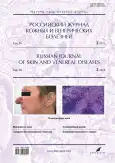Hereditary keratoderma of Unna-Tost in a patient with atopic dermatitis
- Authors: Teplyuk N.P.1, Tavitova A.R.1, Pishulina E.V.1, Smirnov K.V.1, Lomonosov K.M.1
-
Affiliations:
- The First Sechenov Moscow State Medical University (Sechenov University)
- Issue: Vol 26, No 2 (2023)
- Pages: 171-180
- Section: DERMATOLOGY
- Submitted: 28.02.2023
- Accepted: 26.03.2023
- Published: 21.05.2023
- URL: https://rjsvd.com/1560-9588/article/view/296576
- DOI: https://doi.org/10.17816/dv296576
- ID: 296576
Cite item
Abstract
Unna-Toast's keratoderma is a disease belonging to the group of genodermatoses with an autosomal dominant type of inheritance and characterized by hyperkeratosis on the palms and soles. This nosology can manifest itself at any age as an independent process, but more often it debuts at 1–2 years of age, in some cases combined with various congenital malformations of ectodermal origin.
The prevalence of this disease ranks second among hereditary dyskeratoses, however, it is rare in the practice of a dermatologist and there are no static data on the disease.
The article presents a clinical observation of Unna-Toast's keratoderma that first appeared against the background of atopic dermatitis. The clinical picture is represented by smooth yellow horny layers located on the palms and soles, with a sharply defined border and an erythematous corolla along the periphery. Other areas of the skin are represented by lichenification foci with small-lamellar peeling, excoriations and serous-hemorrhagic crusts on the surface.
This clinical case confirms the possibility of manifestation of hereditary hyperkeratosis against the background of aggressive atopic dermatitis. Unna-Tost's keratoderma is of high interest in the practice of a dermatologist and requires a detailed description of the available clinical cases, due to the rare occurrence of this nosology in the population.
Full Text
About the authors
Natalya P. Teplyuk
The First Sechenov Moscow State Medical University (Sechenov University)
Email: Teplyukn@gmail.com
ORCID iD: 0000-0002-5800-4800
SPIN-code: 8013-3256
MD, Dr. Sci. (Med.), Professor
Russian Federation, 4/1 Bolshaya Pirogovskaya street, 119435 MoscowAlana R. Tavitova
The First Sechenov Moscow State Medical University (Sechenov University)
Email: alatavitova@mail.ru
ORCID iD: 0000-0003-1930-0073
SPIN-code: 2113-9091
врач-дерматовенеролог
Russian Federation, 4/1 Bolshaya Pirogovskaya street, 119435 MoscowElizaveta V. Pishulina
The First Sechenov Moscow State Medical University (Sechenov University)
Email: liza.pishulina.98@mail.ru
ORCID iD: 0000-0002-5346-463X
клинический ординатор
Russian Federation, 4/1 Bolshaya Pirogovskaya street, 119435 MoscowKonstantin V. Smirnov
The First Sechenov Moscow State Medical University (Sechenov University)
Email: puva3@mail.ru
ORCID iD: 0000-0001-7660-7958
SPIN-code: 2054-1086
MD, Cand. Sci. (Med.)
Russian Federation, 4/1 Bolshaya Pirogovskaya street, 119435 MoscowKonstantin M. Lomonosov
The First Sechenov Moscow State Medical University (Sechenov University)
Author for correspondence.
Email: lamclinic@yandex.ru
ORCID iD: 0000-0002-4580-6193
SPIN-code: 4784-9730
MD, Dr. Sci. (Med.), Professor
Russian Federation, 4/1 Bolshaya Pirogovskaya street, 119435 MoscowReferences
- Itin PH, Fistarol SK. Palmoplantar keratodermas. Clin Dermatol. 2005;23(1):15–22. doi: 10.1016/j.clindermatol.2004.09.005
- Pashinyan AG, Ilyenko LI, Hakobyan AN. Clinical case of palmar-plantar keratodermia of Unna-Toast. Russ J Skin Venereal Dis. 2017;20(3):143–145. (In Russ). doi: 10.18821/1560-9588-2017-20-3-143-145
- Lee RA. Keratosis palmaris et plantaris. Department of dermatology, Hospital of the University of Pennsylvania; 2006. Р. 1–9.
- Patel S, Zirwas M, English JC. Acquired palmoplantar keratoderma. Am J Clin Dermatol. 2007;8(1):1–11. doi: 10.2165/00128071-200708010-00001
- Lucker GP, van de Kerkhof PC, Steijlen PM. The hereditary palmoplantar keratoses: An updated review and classification. Br J Dermatol. 1994;131(1):1–14. doi: 10.1111/j.1365-2133.1994.tb08450.x
- Teplyuk NP, Orlova EV, Novoselova SV, et al. Keratodermia as a manifestation of paraneoplasia. Russ J Skin Venereal Dis. 2012;15(5):16–19. (In Russ). doi: 10.17816/dv36729
- Lee BY, Hogan DJ, Ursine S, et al. Personal observation of skin disorders in malnutrition. Clin Dermatol. 2006;24(3):222–227. doi: 10.1016/j.clindermatol.2005.11.002
- Ivanov OL. Skin and venereal diseases. Moscow: Chiko; 2006. 477 p. (In Russ).
- Olisova OY, Teplyuk NP. Illustrated guide to dermatology. To prepare doctors for accreditation. Moscow: GEOTAR-Media; 2023. 376 р. (In Russ).
- Grabovskaya OV, Teplyuk NP, Kolesova YV, Ignatiev DV. Hereditary keratodermia. Unna-Toast keratodermia and Buschke-Fischer-Brauer keratodermia: Clinical cases. Russ J Skin Venereal Dis. 2022;25(4):303–312. (In Russ). doi: 10.17816/dv111752
- Kang S, Amagai M, Bruckner AL, et al. Fitzpatrick’s Dermatology, Ninth edition, 2-volume set (Fitzpatricks Dermatology in General Medicine) 9th Edition. McGraw-Hill Education; 2018.
- Bologa EJ. Le complexe geno-ecologigue dansle determinisme des keratosis palmoplantaire. Ann Dermatol Syphilol. 1970;(97):259–266.
- Pashinyan AG, Ilyenko LI, Hakobyan AN. Clinical case of palmar-plantar keratodermia of Unna-Toast. Russ J Skin Venereal Dis. 2017;20(3):143–145. (In Russ). doi: 10.18821/1560-9588-2017-20-3-143-145
- Inamadar AC, Palit A. Nails: Diagnostic clue to genodermatoses. Indian J Dermatol Venereol Leprol. 2012;78(3):271–278. doi: 10.4103/0378-6323.95441
- Mordovtsev VN, Rasskazova NI. Treatment of patients with hereditary skin diseases and psoriasis: A manual on pharmacotherapy for doctors. Astrakhan; 1996. 165 р. (In Russ).
- Bodemer C, Steijlen P, Mazereeuw-Hautier J, O’Toole EA. Treatment of hereditary palmoplantar keratoderma: A review by analysis of the literature. Brit J Dermatol. 2021;184(3):393–400. doi: 10.1111/bjd.19144
- Ponomarenko GN. Physical methods of treatment: Handbook. Saint-Petersburg: S.M. Kirov Military Medical Academy; 2002. 229 p. (In Russ).
- Panetta C, Paolino G, Didona D, et al. Hereditary punctate keratoderma: Clinical, pathology, treatment and follow-up. G Ital Dermatol Venereol. 2017;152(3):322–323. doi: 10.23736/S0392-0488.16.05281-0
Supplementary files











